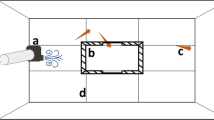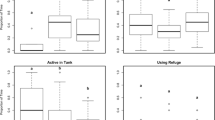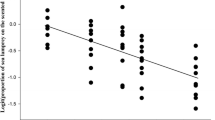Abstract
Predators, either through direct or indirect encounter and current velocity, are frequently stressful to fish living in stream waters. In nature, fish may experience both current velocity stress and predation danger simultaneously. Experiments were carried out to clarify to what extent predation risk (with reference to different types of predatory cues) and current velocity can induce physiological stress in a running-water dwelling fish, topmouth gudgeon (Pseudorasbora parva). Fish were exposed to an alarm substance, predator odor, and visual cue, as well to combinations of predation risk and elevated current velocities. Metabolic rate, ventilation rate and fish activity were measured. Results showed that irrespective of the type of encounter, the presence of predator imposed physiological stress on fish. Metabolic rate were 0.983 ± 0.312, 0.641 ± 0.151, 0.572 ± 0.063, and 0.277 ± 0.016 mg O2 W−1 h−1 following presence of alarm substance, visual cue, predator odor and control, respectively. Dramatic changes in ventilation rate and activity affirmed that alarm substance induced the strongest stress, followed by predator odor and visual cue. Reactions appeared to mirror the extent of fish perceiving danger of predation. Predation risk together with current velocity induces stronger stress, much stronger than if the current velocity works as a single stressor. However, the interaction between predation risk and current velocity did not have a significant effect on metabolic function; magnitude of metabolic response to high current velocity might mask the metabolic response to predator presence. Small fish living in stream habitats that face local predation risk would spend higher energy expenditure that may have negative impacts on growth, and hence their fitness.
Similar content being viewed by others

References
Azuma M (1992) Ecological release in feeding behavior: the case of bluegills in Japan. Hydrobiologia 243: 269–276
Bell WH, Terhune LDB (1970) Water tunnel design for fisheries research. J Fish Res Bd Can Technical Rep 195:1–69
Brett JR, Glass NR (1973) Metabolic rate and critical swimming speed of sockeye salmon (Oncorhynchus nerka) in relation to size and temperature. J Fish Bd Can 30:379–387
Brett JR, Groves TDD (1979) Physiological energetics. In: Hoar WS, Randall DJ, Brett JR (eds) Bioenergetics and growth. Academic Press, New York, pp 279–352
Brown GE (2003) Learning about danger: chemical alarm cues and local risk assessment in prey fishes. Fish Fisheries 4:227–234
Brown GE, Paige JA, Godin J-GJ (2000) Chemically mediated predator inspection behaviour in the absence of predator visual cues by a characin fish. Anim Behav 60:315–321
Brown GE, Chivers DP, Smith RJF (1997) Differential learning rates of chemical versus visual cues of a northern pike by fathead minnows in a natural habitat. Environ Biol Fish 49:89–96
Chivers DP, Smith RJF (1995) Free-living fathead minnows rapidly learn to recognize pike as predator. J Fish Biol 46:949–954
Diaz H, Orihuela B, Forward RB Jr, Rittschot D (1999) Orientation of blue crab, Callinectes sapidus, (Rathbun), Megalopae: responses to visual and chemical cues. J Exp Mar Biol Ecol 233:25–40
Economidis P, Dimitriou E, Pagoni R, Michaloudi E, Natsis L (2000) Introduced and translocated fish species in the inland waters of Greece. Fish Manag Ecol 7:239–250
Facey DE, Grossman GD (1992) The relationship between water velocity, energetic costs, and microhabitat use in four North American stream fishes. Hydrobiologia 239:1–6
Fuiman LA, Magurran AE (1994) Development of predator defences in fishes. Rev Fish Biol Fish 4: 145–183
Gelowitz CM, Mathis A, Smith RJF (1993) Chemosensory recognition of northern pike (Esox lucius) by brook stickleback (Culaea incostans): population differences and the influence of predator diet. Behaviour 127: 105–118
Hambright KD, Drenner RW, McComas SJ, Hairston NG Jr (1991) Gape-limited piscivores, planktivore size refuges, and the trophic cascade hypothesis. Hydrobiologia 121:389–404
Hawkins LA, Armstrong JD, Magurran AE (2004) Predator-induced hyperventilation in wild and hatchery Atlantic salmon fry. J Fish Biol 65:88–100
Hill J, Grossman GD (1993) An energetic model of microhabitat use for rainbow trout and rosyside dace. Ecology 74:685–698
Huuskonen H, Karjaleinen J (1997) Predator-induced respiratory responses in juveniles of vendace Coregonus albula, whitefish C. lavaretus, perch Perca fluviatilis and roach Rutilus rutilus. Environ Biol Fish 49:265–269
Jachner A (1995) Changes in feeding behavior of bleak (Alburnus alburnus). Arch Hydrobiol 133:305–314
Jachner A (2001) Anti-predator behaviour of naïve compared with experienced juvenile roach. J Fish Biol 59:1313–1322
Kats LB, Dill LM (1998) The scent of death: chemosensory assessment of predation risk by prey animals. Ecoscience 5:361–394
Krause J (1993) The effect of ‘schreckstoff ’ on shoaling behaviour of the minnow: a test of Hamilton’s selfish herd theory. Anim Behav 45:1019–1024
Magurran AE (1989) Acquired recognition of predator odour in the European minnow (Phoxinus phoxinus). Ethology 82:216–223
Magurran AE (1990) The adaptive significance of schooling as an anti-predator defence in fish. Ann Zool Fenn 27:51–66
Maitland PS (1977) Freshwater fishes of Britain and Europe. Hamlyn Publishing, London
Mathis A, Smith RJF (1993) Fathead minnows, Pimephales promelas, learn to recognize northern pike, Esox lucius, as predators on the basis of chemical stimuli from minnows in the pike’s diet. Anim Behav 46: 645–656
Metcalfe NB, Huntingford FA, Thorpe JE (1987) The influence of predation risk on the feeding motivation and foraging strategy of juvenile Atlantic salmon. Anim Behav 35:901–911
Mirza RS, Fisher SA, Chivers DP (2003) Assessment of predation risk by juvenile yellow perch, Perca plavesens: responses to alarm cues from conspecifics and prey guild members. Environ Biol Fish 66:321–327
NFIWFC (National Federation of Inland Water Fisheries Cooperatives) (2002) Tomaranai mitsuhoryu! Gairaigyo no seisokuiki sarani kakudai (Nonstopping illegal stocking! Enlarged distribution of alien fish). Naisuimen 27:12–14 (in Japanese)
Pearl CA, Adam MJ, Schuytema GS, Nebeker AV (2003) Behavioral responses of anuran larvae to chemical cues of native and introduced predators in the Pacific Northwestern United States. J Herpet 37:572–576
Powers SP, Kittinger JN (2002) Hydrodynamic mediation of predator-prey interactions: differential patterns of prey susceptiblity and predator success explained by variation in water flow. J Exp Mar Biol Ecol 273: 171–187
Rehnberg BG, Smith RJF, Sloley BD (1987) The reaction of pearl dace (Pisces, Cyprinidae) to alarm substance: timecourse of behavior, brain amines, and stress physiology. Can J Zool 65:2916–2921
Rehnberg BG, Schreck CB (1987) Chemosensory detection of predators by coho salmon (Oncorhynchus kisutch): behavioral reaction and physiological stress response. Can J Zool 65:481–485
Shave CR, Townsend CR, Crowl TA (1994) Anti-predator behaviours of a freshwater crayfish (Paranephrops zealandicus White) to a native and an introduced predator. NZ J Ecol 18:1–10
Smit H, Amelink-Koustaal JM, Vijverberg J, von Vaupel-Klein JC (1971) Oxygen consumption and efficiency of swimming goldfish. Compar Biochem Physiol 39A:1–28
Smith RJF (1992) Alarm signals in fishes. Rev Fish Biol Fish 2:33–63
Smith RJF (1999) What good is smelly stuff in the skin? Cross-function and cross-taxa effects in fish “alarm substances”. In: Johnston RE, Muller-Schwarsze D, Sorensen PW (eds) Advances in chemical signals in vertebrates. Kluwer Academic, New York, pp 475–488
Suboski MD (1990) Releaser-induced recognition learning. Physiol Rev 97:271–284
Sunardi, Asaeda T, Manatunge J (2005) Foraging of a small planktivore (Pseudorasbora parva: Cyprinidae) and its behavioral flexibility in an artificial stream. Hydrobiologia 549:155–166
Acknowledgements
We thank to the Ministry of Science, Culture and Sports (Monbukagakusho), Japan, who granted a postgraduate scholarships to the first author to carry out this research work.
Author information
Authors and Affiliations
Corresponding author
Rights and permissions
About this article
Cite this article
Sunardi, Asaeda, T. & Manatunge, J. Physiological responses of topmouth gudgeon, Pseudorasbora parva, to predator cues and variation of current velocity. Aquat Ecol 41, 111–118 (2007). https://doi.org/10.1007/s10452-006-9048-0
Received:
Accepted:
Published:
Issue Date:
DOI: https://doi.org/10.1007/s10452-006-9048-0



